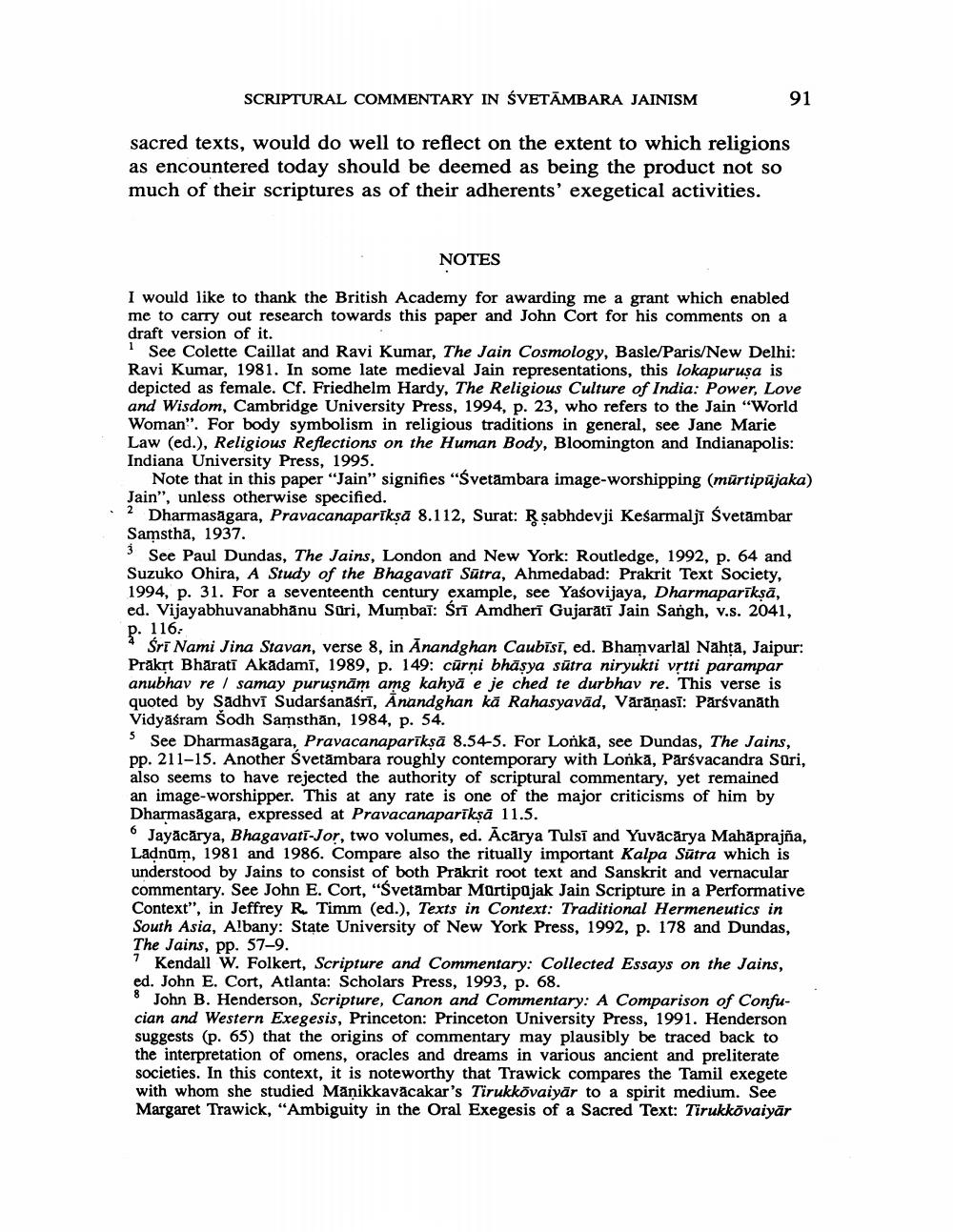________________
SCRIPTURAL COMMENTARY IN SVETĀMBARA JAINISM
91
sacred texts, would do well to reflect on the extent to which religions as encountered today should be deemed as being the product not so much of their scriptures as of their adherents' exegetical activities.
NOTES
I would like to thank the British Academy for awarding me a grant which enabled me to carry out research towards this paper and John Cort for his comments on a draft version of it. 1 See Colette Caillat and Ravi Kumar, The Jain Cosmology, Basle/Paris/New Delhi: Ravi Kumar, 1981. In some late medieval Jain representations, this lokapurusa is depicted as female. Cf. Friedhelm Hardy, The Religious Culture of India: Power, Love and Wisdom, Cambridge University Press, 1994, p. 23, who refers to the Jain "World Woman". For body symbolism in religious traditions in general, see Jane Marie Law (ed.), Religious Reflections on the Human Body, Bloomington and Indianapolis: Indiana University Press, 1995.
Note that in this paper "Jain" signifies "Svetambara image-worshipping (mūrtipūjaka) Jain", unless otherwise specified. 2 Dharmasagara, Pravacanaparīksā 8.112, Surat: R sabhdevji Keśarmalji Śvetambar Samstha, 1937. 3 See Paul Dundas, The Jains, London and New York: Routledge, 1992, p. 64 and Suzuko Ohira, A Study of the Bhagavati Sūtra, Ahmedabad: Prakrit Text Society, 1994, p. 31. For a seventeenth century example, see Yaśovijaya, Dharmaparīksā, ed. Vijayabhuvanabhanu Suri, Mumbai: Sri Amdherī Gujarati Jain Sangh, v.s. 2041,
p. 116.
4 Śrī Nami Jina Stavan, verse 8, in Anandghan Caubisi, ed. Bhamvarlal Nahta, Jaipur: Prakrt Bharati Akadami, 1989, p. 149: cūrni bhäsya sütra niryukti vrtti parampar anubhav re / samay purusnām amg kahyā e je ched te durbhav re. This verse is quoted by Sadhvi Sudarsanaśrī, Anandghan kā Rahasyavād, Varanasi: Parsvanath Vidyaśram Sodh Samsthān, 1984, p. 54. 5 See Dharmasagara, Pravacanapariksā 8.54-5. For Lonka, see Dundas, The Jains, pp. 211-15. Another Svetambara roughly contemporary with Lonka, Parávacandra Sari, also seems to have rejected the authority of scriptural commentary, yet remained an image-worshipper. This at any rate is one of the major criticisms of him by Dharmasāgara, expressed at Pravacanapariksā 11.5. • Jayācārya, Bhagavati-Jor, two volumes, ed. Ācārya Tulsī and Yuvācārya Mahāprajña, Ladnum, 1981 and 1986. Compare also the ritually important Kalpa Sūtra which is understood by Jains to consist of both Prakrit root text and Sanskrit and vernacular commentary. See John E. Cort, "Svetambar Martipujak Jain Scripture in a Performative Context", in Jeffrey R Timm (ed.), Texts in Context: Traditional Hermeneutics in South Asia, Albany: State University of New York Press, 1992, p. 178 and Dundas, The Jains, pp. 57-9. 7 Kendall W. Folkert, Scripture and Commentary: Collected Essays on the Jains, ed. John E. Cort, Atlanta: Scholars Press, 1993, p. 68. 9 John B. Henderson, Scripture, Canon and Commentary: A Comparison of Confucian and Western Exegesis, Princeton: Princeton University Press, 1991. Henderson suggests (p. 65) that the origins of commentary may plausibly be traced back to the interpretation of omens, oracles and dreams in various ancient and preliterate societies. In this context, it is noteworthy that Trawick compares the Tamil exegete with whom she studied Manikkavācakar's Tirukkovaiyar to a spirit medium. See Margaret Trawick, "Ambiguity in the Oral Exegesis of a Sacred Text: Tirukkovaiyar




